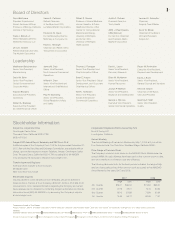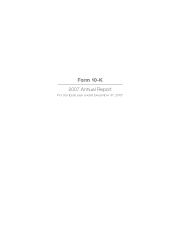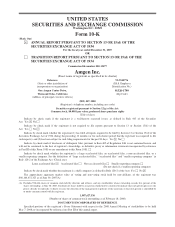Amgen 2007 Annual Report Download - page 19
Download and view the complete annual report
Please find page 19 of the 2007 Amgen annual report below. You can navigate through the pages in the report by either clicking on the pages listed below, or by using the keyword search tool below to find specific information within the annual report.Accomplishments
Despite these significant challenges, we were encouraged by certain notable accomplishments in 2007 and
early 2008. For example, we successfully defended our intellectual property in 2007 with the October 23, 2007,
jury verdict in the U.S. Federal District Court in Boston and the Court’s rulings on various pre-trial and post-trial
motions whereby Roche was found to infringe a total of 10 claims from four of Amgen’s erythropoietin product
(“EPO”) patents.
Furthermore, our pipeline continued to advance in 2007. Our early stage pipeline achieved significant ex-
pansion and our late-stage clinical programs, including denosumab, continued to progress. In January 2008, we
announced that our one-year, head-to-head study of denosumab versus alendronate met primary and all secon-
dary endpoints. In addition, we submitted a Biologics License Application (“BLA”) with the FDA for Nplate™
(Romiplostim) for the treatment of thrombocytopenia in adult patients with chronic immune (idiopathic)
thrombocytopenic purpura (“ITP”) in October 2007 and also completed regulatory filings for this indication in
Europe, Canada and Australia. The FDA has granted priority review of Nplate™, which will be discussed at the
March 12, 2008 ODAC meeting, and we expect a regulatory decision in the first half of 2008. Further, on De-
cember 5, 2007, the European Commission granted a conditional marketing authorization for Vectibix™ as
monotherapy for the treatment of patients with epidermal growth factor receptors (“EGFr”) expressing mCRC
with non-mutated (wild-type) KRAS genes after failure of standard chemotherapy regimens. On January 24,
2008, we announced the results of a biomarker analysis which indicated that in mCRC patients who have failed
all other chemotherapeutic regimens, the efficacy of Vectibix™ monotherapy is confined to patients with
non-mutated (wild-type) KRAS tumors. Specifically, in patients with non-mutated KRAS tumors, Vectibix™
significantly increased PFS and had an impact on quality of life and disease-related symptoms, compared to best
supportive care alone.
We also entered into partnering agreements, including a collaboration and license agreement with Daiichi
Sankyo Company, Limited (“Daiichi Sankyo”) in July 2007, which provided them the exclusive rights to develop
and commercialize denosumab in Japan in postmenopausal osteoporosis (“PMO”) and oncology with the poten-
tial for additional indications. In February 2008, we entered into a license agreement with Takeda Pharmaceutical
Company Limited (“Takeda”), which provided them the exclusive rights to develop and commercialize for the
Japanese market up to 13 early to mid-stage molecules from our pipeline across a range of therapeutic areas, in-
cluding oncology and inflammation. The molecules covered by the license agreement primarily include: AMG
108, AMG 317, AMG 386, AMG 479, AMG 655 and Vectibix™ (panitumumab). Amgen has the right to partic-
ipate in the promotion of these products in Japan. In addition, we entered into a collaboration agreement with
Takeda for the worldwide development and commercialization of motesanib diphosphate (AMG 706). Each party
has the right to participate in the commercialization of motesanib diphosphate in the other party’s territory. In
connection with these agreements, Takeda has agreed to acquire our subsidiary in Japan, Amgen K.K.
During 2007, we acquired Alantos Pharmaceuticals Holding, Inc. (“Alantos”), which was a privately held
company that specialized in the development of drugs for the treatment of diabetes and inflammatory diseases,
and Ilypsa, Inc. (“Ilypsa”), which was a privately held company that specialized in the development of
non-absorbed drugs for renal disorders.
Principal Products
We market our principal products in the areas of supportive cancer care, nephrology and inflammation. Our
principal products include Aranesp®, EPOGEN®, Neulasta®, NEUPOGEN®and ENBREL. As discussed above,
certain of our products, principally our marketed ESA products, Aranesp®and EPOGEN®, have and will con-
tinue to face various challenges arising primarily from regulatory and reimbursement developments that began in
2007. The developments involving our marketed ESA products have and will continue to materially adversely af-
fect product sales, particularly Aranesp®sales in the U.S. supportive cancer care segment, as physicians conform
to label and reimbursement changes. EPOGEN®sales have also, to a lesser degree, been negatively affected as
physician behavior in making treatment and dosing decisions has reflected the issuance by the NKF of the final
7
























